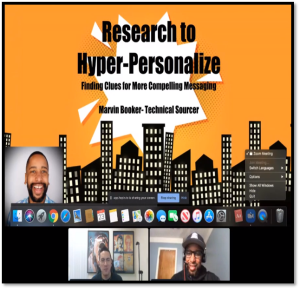
There’s always tension in recruiting. The tension that manifests itself in trade-offs. Trade-offs between what recruiting/talent sourcing practitioners are advocating and your capacity to integrate their ideas into your daily workflow.
Trade-offs between performing your jobs at the highest level and executing your tasks at the highest level that time allows. Trade-offs between necessary upskilling/reskilling and doing things the way you have always done them.
One of the most impactful tradeoffs that recruiters/talent sourcers make is the choice to craft a highly personalized engagement message or just to “mail it in (pun intended).” As Marvin Booker points out in his SourceCon Digital presentation mailing it in or slacking off in messaging can be overcome by performing research on the target talent that will provide clues to crafting a more compelling message.
The trade-off that is underlying Marvin’s presentation is–do I need to perform the research to be an effective recruiter/talent sourcer? It’s a real-life dilemma for you as you work in this do more with less economy.
ICYMI (In Case You Missed It), I would like to provide an overview of Marvin’s presentation and share some of his insights. Insights worthy of your consideration if you are considering crafting more compelling messaging to up your recruiting game. Not farfetched ideas, but things that you can add to your talent sourcing workflow immediately.
Marvin is a storyteller. And in a very real sense, the article is the story of a storyteller. If Marvin’s background is unfamiliar to you, you can check out his background on LinkedIn. Mentored by my friend Todd Davis, Marvin has honed his talent sourcing chops by learning from others and applying those learnings to his own experience. In other words, Marvin is not recycling the same old stuff but offers a fresh perspective. Marvin inspires us to craft more compelling messages by sharing 4 rules of talent engagement using hyper-personalization. I call those suggestions Marvinism’s. The 4 Marvinism’s are:
Marvinism #1: Marvin’s Golden Rule: “don’t send something that you would not want to receive”
The context of the Golden Rule began with a recruiter’s daydream. Marvin had us imagine beginning a remarkable day in which we conduct a search and find that amazing candidate with the right education, the right skills, the right location, every detail of the candidate’s profile maps to your requisition. Then a dose of reality awakens you. The pleasant dream turns into a nightmare of an email.
Perhaps you recognize the handwriting? I do. I have sent my version of that email. An email designed from my perspective to make my recruiting process more expedient. IMO while we embrace that we live in a prospect driven world, that knowledge has not translated into our recruiting process, especially our prospect engagement.
What is wrong with the nightmare email? Marvin identified several problems with the email, including a presumption that an archived candidate would be ready to interview without discussing the job with the recruiter. Without the former candidate’s permission or expression of interest, an interview was already set up with a hiring manager. Perhaps the biggest fault on this email was the recipient that was targeted.
Ironically, the technical recruiting letter was received by a technical sourcer, not a technical engineer. This email was canned, and the recruiter did not do their homework (note: the hiring manager has reviewed your background-highlighted in red). Marvin added the suggestion that this message would only be relevant if the hiring leader was interested in replacing the recruiter that sent the email in the first place. Unfortunately, this is not an isolated example.
Marvinism #2: Sending an email is like shooting an arrow “once you fire it, it can’t be stopped”
Marvin’s advice, before you press SEND, rethink why you are sending the email. His metaphor is pressing send is like shooting an arrow. Once you fire it, it cannot be stopped.”
A fundamental question that Marvin asked rhetorically was—why are you reaching out? Is it because you have a goal to hit or a KPI to achieve, or a box to check? Let’s think about that for a moment. Many of us have been taught that recruiting is a “numbers game.” If we perform a certain number of activities, then we can enjoy a certain level of success. I believe that to be true. I was raised on “numbers.” That said, Marvin suggests this is a cautionary method.
The downside of focusing on a number marginalizes the target talent that is the recipient of the email. Not only do you marginalize the PERSON on the receiving end of the message, but you also run the risk of wasting their time. And that can damage your company’s image as well as your “personal” brand.
More about the Why
Marvin provided pertinent lessons from Start with Why from noted author and motivational speaker Simon Sinek. Sinek reminds us that while organizations know what they do and how they do it—getting to “the why” is to identify the “purpose, cause or core belief.” For example, “why should anyone care” about your brand. Also, consider, “why does your organization exist?” Sinek concludes that “people do not buy what you do; they buy why you do it.”
Marvin, like Sinek, is suggesting that your email should include why you are reaching out to the prospect. So, in the nightmare email above, the recruiter indicated that he was reaching out because he saw your resume in a database. This recruiter was just checking a box on his KPI’s, and it was not a well-planned outreach.
What do you do to avoid a misspent arrow? Marvin suggests that you should always be certain of your target.
- State how you found them, what you found interesting
- Why you reached out
- What you plan to do if they respond
- What their call to action should be
- Give them something valuable
Marvinism #3: If it is not broke, break it.
I found Marvin’s suggestion-if it’s not broke, break it to be on point. He wasn’t talking about breaking a toy; he was talking about breaking out of your typical pattern. And that break out takes the form of additional research. Research that will make you competitive in this world of hyper-personalization.
A word about the competition
IMO: I don’t know whether you realize it or not, but the FAANG (Facebook, Amazon, Apple, Netflix, and Google), as well as Microsoft, Uber, and the like, have armies of talent sourcers and recruiters. These recruiters are sub segmenting the marketplace and are conducting very specialized outreach. They carry only a handful of requisitions and are building relationships with their target talent audiences. If you are competing for the same talent and use a generic email, you do not stand a chance. IMO, these organizations are hiring recruiters and talent sources because advertising, generic messaging, and the traditional approaches will not allow them to meet their workforce plans.
So how does a recruiter or talent sourcer compete when you work for a “do more with less” organization? Marvin has some suggestions for you. Research is recommended by Marvin as a way to identify elements that can add to message personalization. He broke those suggested sites into some easy to remember segments.

Boolean is the language of talent sourcers and recruiters. And Marvin is a strong advocate that we must use Boolean in our research.
Marvin suggests that we become an X-Ray Tactician and practice these searches on our own.
Personal websites:



Tools for personalization
One thing for certain at a talent sourcing focused conference; there is a strong likelihood that if you speak on the next to the last day of the conference, someone else has mentioned the tool that you will use previously. Marvin did a nice job of weaving the suggestions of other speakers into his presentation.


Marvinism #4: Storytelling may be the only way to change someone’s mind.
Who doesn’t love a good story? The greatest challenge for email messaging is to craft an engaging story with just words. The recruiter/talent sourcer can tell the story over a series of emails or use the emails to invite prospects to landing pages that tell the story using different forms of media (video, testimonials, images, etc.).
Marvin offered great insights on why we should use a story in our messaging. He offered some reasons and the resources to dive deeper into the subject. He suggested that a combination of empathy, neuroscience, sensory words, and weaving data into the story will greatly enhance your messaging.
If you want to explore storytelling in greater detail, Marvin provided these links in his presentation.
- One of the 8 facts about the Neuroscience of Storytelling is that Oxytocin, a chemical in the brain connected to empathy, is released during storytelling. To view the other 7, check this link.
- A variety of sources are quoted in this article to conclude if you want to change current attitudes, beliefs, knowledge, and behavior, then storytelling is effective.
One final thing about storytelling. The hero of the story is not you nor your brand; it is the prospect. One of the lessons of the digital age is that it is all about them and not about us. Marvin quotes storytelling expert Ron Ploof when he suggests that by putting the customer as the hero of the Storytelling, it is easier for the customer to relate to the story. The brand acts as a mentor, and the product or service is the magical gift the hero will need to defeat the enemy. See this for more information.
So, what does a great message look like? Marvin showed us one of his from a previous gig. I noticed the warmth, the knowledge of the domain, and making Dr. Johnson the heroine of this message.

Marvin offered one final bit of coaching; be sure to iterate.
Iteration (It·er·a·tion)
Iteration is the repetition of a process to generate a sequence of outcomes. The sequence will approach some endpoint or end value. For example, Marvin suggested 4 things to iterate; they are.

Well, there you have it, 4 Marvinism’s to consider.
- “Don’t Send Something That You Would Not Want to Receive”
- Sending an Email Is Like Shooting an Arrow “Once You Fire It, It Can’t Be Stopped”
- If It Is Not Broke, Break It
- Storytelling May Be the Only Way to Change Someone’s Mind.
You face that trade-off that began this article—the tension between upskilling to hyper-personalized messaging or continuing to do things the way you always have.
Admittedly, there is a deal of information in Marvin Booker’s presentation to digest. A lot of material to get your head around. To put this in storytelling terms, you are the hero of your story, and Marvin is the guide or mentor. Assimilating the information is the magical gift that you receive if you adapt this hyper-personalized methodology.
